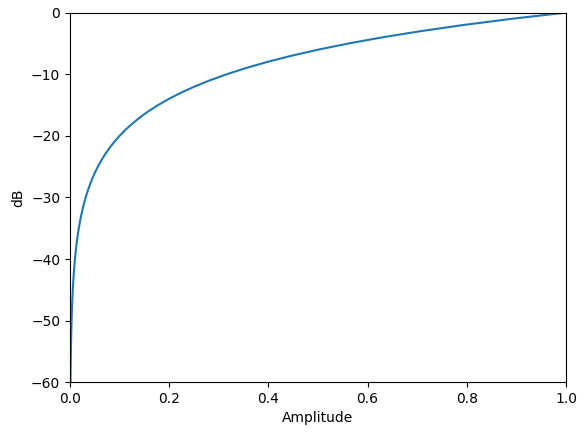decibel
Overview
 The decibel (dB) is a unit used to measure the relative signal level difference between two signals. It is a logarithmic scale that expresses the relationship between two signal root-power amplitudes or power levels. Here, we are concerned with amplitudes.
The decibel (dB) is a unit used to measure the relative signal level difference between two signals. It is a logarithmic scale that expresses the relationship between two signal root-power amplitudes or power levels. Here, we are concerned with amplitudes.
For amplitudes gain, the relationship is given by:
20 log10(out/in) = dBwhere out represents the output amplitude, while in represents the input amplitude.
The decibel scale is expressed as the base 10 logarithm of the ratio between two amplitudes. For instance, a ratio of 2:1 (two times) corresponds to a 6 dB increase, while a ratio of 10:1 (ten times) corresponds to a 20 dB increase. In contrast, a ratio of 1:2 (one half) corresponds to a -6 dB decrease, whereas a ratio of 1:10 (one tenth) corresponds to a -20 dB decrease.
Decibel is non-linear and operates on the logarithmic domain. The decibel class is perfectly suitable for dynamics processing (e.g. compressors and limiters and envelopes). Q provides fast decibel computations using fast math functions and lookup tables for converting to and from scalars.
Declaration
struct decibel_unit;
struct decibel : _unspecified_base_type_
{
using base_type = _unspecified_base_type_;
using base_type::base_type;
using unit_type = decibel_unit;
};
// Free functions
double lin_double(decibel db);
constexpr float lin_float(decibel db);
inline decibel approx_db(float val);
decibel lin_to_db(double val);
// Literals
inline namespace literals
{
constexpr decibel operator "" _dB(unsigned long long int val);
constexpr decibel operator "" _dB(long double val);
}Expressions
decibel is a model of Unit. In addition to valid expressions for Unit, decibel allows these expressions.
Notation
d-
Object of type
decibel. v-
Linear floating point value.
0.0-
A floating point literal number.
0-
An integer literal number.
Constructor
Take note that the Unit concept already has a constructor from a floating point value that handles direct construction such as:
auto db = decibel{6.0}; // 6 dB| This constructor was used in previous versions of the library to convert linear to decibels, which can be confusing. This version ought to have corrected this nonintuitive semantics, but this is a disruptive change that will alter the semantics of all existing code without warning. In order to avoid further confusion, we will mark this constructor as deleted for the time being, making it a hard error to alert users upgrading to this library version. |
| C++ brace initialization may also be used. |
Conversions
| Expression | Semantics | Return Type |
|---|---|---|
|
Convert |
|
|
Convert |
|
|
Convert a linear value |
|
|
Faster approximate conversion from
a linear value |
|
The free function lin_to_db can be used to indirectly construct and return a decibel object from a linear value. The lin_to_db function performs linear to decibel conversion. Example:
auto db = lin_to_db(2.0); // 6 dBIn addition to lin_to_db, approx_db is another free function that performs linear to decibel conversion. It is a faster, but less accurate conversion function from a linear value to decibel.
lin_float and lin_double convert decibel to a linear value with float and double results, respectively.
Literals
If you need to create decibel from numeric constants, it is preferrable to use decibel literals instead. Example:
auto db = -6_dB;| Expression | Semantics |
|---|---|
|
Returns 0.0 dB. |
|
Returns 0.0 dB. |
Take note that 0.0 and 0 stand for any floating point, and integer numeric literals.
Unless you have a conflicting usage for the _dB literal, it is generally safe to bring its namespace into scope using the using namespace cycfi::q::literals directive anywhere in a cpp file.
|